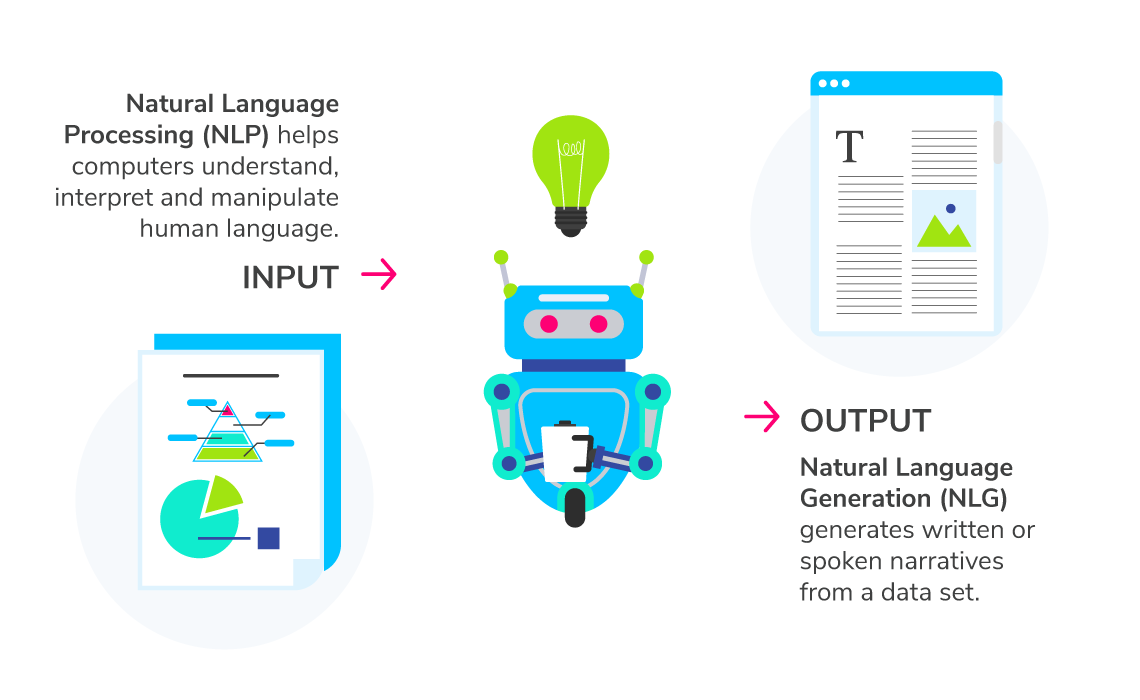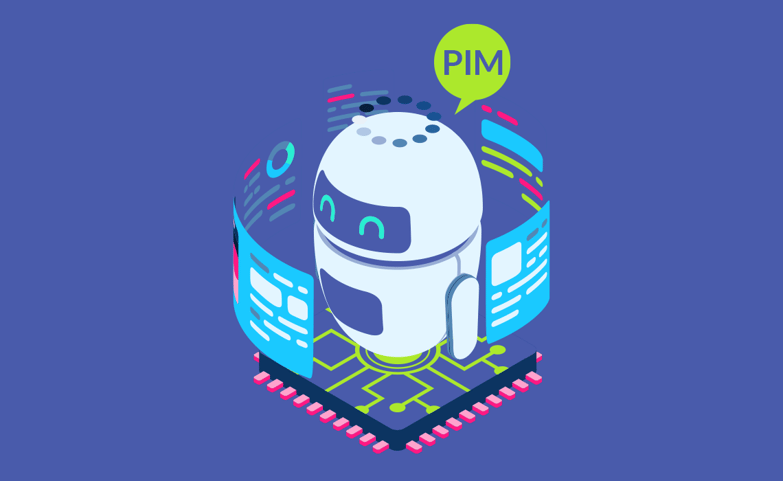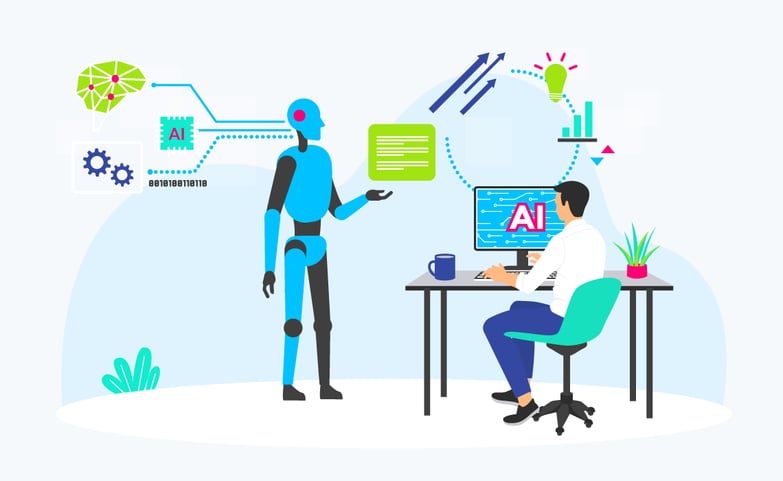In recent years, we've seen disruptive innovations that have revolutionized the way we approach content creation. Artificial intelligence (AI) has already impacted virtually every industry. But automated text generation is one of AI’s most exciting applications with the global text generator market expected to grow at a CAGR of 17.3% between 2022 and 2030. From product descriptions to robot journalism, automated text generation is increasingly being used to keep up with the growing demand for tailored and easily digestible content.
AI text generators are designed to help businesses produce high-quality content more efficiently by automating some of the tedious and time-consuming tasks involved in content creation. In this article, we’ll delve into what automated text generation is and how it works. Finally, we’ll introduce you to five of the most exciting AI writing tools on the market.
What is automated text generation?
Automated text generation is the creation of natural language texts via computer systems. It leverages knowledge in computational linguistics and AI, especially in its natural language processing (NLP) subfield, to generate natural language texts with minimal human intervention. It’s powered by a method of AI called a neural network, which is a computer system that’s designed to mimic the way the human brain operates.
How does automated text generation work?
AI text generators work by creating text through natural language processing (NLP) and natural language generation (NLG) methods. This form of content generation is increasingly used to supply enterprise data, customize materials and deliver personalized product descriptions. Algorithms organize and create NLG-based content. Such text generation models enable users to convert information from a structured format such as a table with different text building blocks into natural language.
Language models trained on billions of sentences learn common linguistic patterns and can generate natural-sounding sentences by predicting likely sequences of words, phrases, and paragraphs with contextual information. AI text generators often include various techniques, such as grammar checking, spell checking and context-aware generation to ensure the quality of the generated text.
 AI-based NLP processes large volumes of unstructured data while NLG makes data universally understandable
AI-based NLP processes large volumes of unstructured data while NLG makes data universally understandable
The evolution of automated text generation
The first natural language processing (NLP) applications were mostly rule-based and were later replaced by machine learning models. Eventually, deep learning models and learning techniques based on convolutional neural networks (CNNs) and recurrent neural networks (RNNs) were used to enable NLP systems that “learn” as they work and extract meaning from huge volumes of raw data.
More recently, transformers have gained popularity over traditional RNNs. Transformers are a deep learning model that adopts a self-attention mechanism that directly models relationships between all words in a sentence, regardless of their respective position. BERT (Bidirectional Encoder Representations from Transformers), developed by Google is a neural network technique based on this model.
Top 5 AI writing tools
These AI writing tools use advanced algorithms and machine learning techniques to understand and interpret content from the web, generate long-form content, reduce writing errors and increase overall production time.
1. GPT-3 by OpenAI
GPT-3, developed by OpenAI, is capable of generating human-like text and has a wide range of applications, including language translation, language modeling and generating text for applications such as chatbots, with ChatGPT being the most popular. A GPT-3-powered tool consists of a suite of diverse capabilities to attract business leaders. Since its release in 2020, this breakthrough technology has found various use cases, especially in the NLP domain, and it’s used by more than 300 applications across varying categories, from productivity and creativity to education and games. Microsoft recently announced the third phase of its partnership with OpenAI with a multibillion-dollar investment to advance AI research.
2. Jasper
Jasper (formerly known as Jarvis) is one of the most well-known AI content writers out there. Through templates and commands, Jasper uses the latest advances in AI technology (GPT-3) to understand and learn from users’ writing style, preferences and ideas to create content. It has more than 50 AI content generation templates, including blog posts, emails, marketing copy, SEO meta titles and descriptions, press releases and more.
3. Rytr
This tool uses world-leading AI technologies to help users analyze semantic keywords, write search intent-focused articles and optimize content for faster and better search engine results. Rytr uses GPT-3 and Proprietary AI to generate content for more than 25 different use cases, offering multiple features that are useful for both beginners and experts looking for a way to improve their productivity.
4. Grammarly
Grammarly is an AI-powered writing assistant that helps users improve the readability of their content. It combines machine learning with a variety of natural language processing approaches that check for clarity, conciseness, correctness and more. The company’s success is largely due to its focus on a narrow application of NLP: grammar assistance.
5. CopyAI
CopyAI is a high-quality tool that enables users to produce authentic, human-like copy almost instantly. It uses GPT-3 and offers a wide selection of templates — from blog ideas and outlines, thought leadership pieces, social media content and email marketing copy to case study templates, video content and website copy.
Next-Gen PIM: What can AI do for product information management?
AI and NLP have driven many industries forward with data-centric automation, which eliminates substantial amounts of manual labor required to perform data-driven tasks. AI achieves the same for Product Information Management (PIM). When directly integrated with a PIM solution, AI tools can help automate and accelerate various tasks around the creation, enrichment and roll-out of product content.
These tasks include, for example, translation management capabilities that are part of a PIM system’s spectrum. Advanced translation tools, such as DeepL, for example, use AI to quickly transfer text as accurately as possible to another language. Another task that can be automated is the creation of high-quality text based on granular product data. Content generation solutions like Retresco enable users to transfer data from the PIM system into high-quality product texts and perform real-time content aggregation.
Additionally, an AI-powered PIM solution addresses a wide range of data management needs that translate into benefits like analyzing and tagging images and comparing them to product descriptions as well as enhancing the content creation process. NLG software companies such as AX Semantics are at the forefront of helping businesses accelerate the creation of large amounts of marketing text for any number of SKUs. Thus, enabling users to achieve critical time savings and streamlined workflows, resulting in accelerated time-to-market.
It won’t be long before advanced PIMs using AI will be able to utilize descriptors paired with image data to automatically categorize or enrich products. The use of AI in PIM also helps create a contextualized and seamless pathway for businesses, providing new insights gathered from various products and customer data sets across channels.
Overall, AI has the potential to revolutionize the way businesses manage and optimize their product information. By improving and automating data management, content creation and personalization, AI can help companies drive growth and improve their bottom line. But for the best results, especially from the most cutting-edge AI tools, it all starts with storing your product data in a logical and systematic structure. Thankfully, creating structure and order within your product information is exactly what a PIM system does for you.




